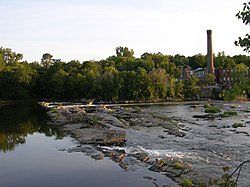Burlington Mills
|
Winooski Falls Mill District
|
|

Chace Mill on the Winooski Falls
|
|
| Location | Winooski and Burlington, Vermont |
|---|---|
| Coordinates | 44°29′20″N 73°11′15″W / 44.488889°N 73.1875°WCoordinates: 44°29′20″N 73°11′15″W / 44.488889°N 73.1875°W |
| Area | 20 acres (8.1 ha) (original size) 1.4 acres (0.57 ha) (size of 1993 increase) |
| NRHP reference # |
79000223 (original) 93001009 (increase 1) 09000916 (increase 2) |
| Significant dates | |
| Added to NRHP | May 9, 1978 |
| Boundary increases | September 30, 1993 November 12, 2009 |
The Winooski Falls Mill District is located along the Winooski River in the cities of Winooski and Burlington, Vermont, in the United States of America. It encompasses a major industrial area that developed around two sets of falls on the river in the 19th century.
The Winooski River flows from the southeast into Burlington Bay, Lake Champlain. The city of Burlington in Chittenden County, Vermont is on the south bank and Winooski and Colchester on the north. It is 45 miles (72 km) from the Canada–US border. There are two sets of falls on the river; the settlement of Winooski is placed between the falls. The historic district refers to the mills built on both banks at the lower falls. The designated district stretches on the northern bank of the river to Center and Canal Streets, including 110 West Canal Street, and on the southern bank including Burlington addresses 485 to 497 Colchester Avenue, 5 to 21 Mill Street and 10 to 32 (even numbers only) Barrett Street. The Burlington addresses represent a 1993 enlargement of the district.
In 1789, Ira Allen, one of the towns founders built a dam across the upper falls, and used it to power two saw mills to provide cut timber for the British market in Québec. It was in 1835 that the water rights to the Colchester bank were secured and in 1835 the Burlington Woolen Mill was constructed beneath the lower falls. They followed the employment patterns used in Lowell, Massachusetts, and employed single girls to work in the mills. A series of tenement houses were built to house the operatives, on common land on the hill leading to Winooski Falls Village. The second mill, the Winooski Mill, a cotton mill, was built in 1846 by the Winooski Mill Company on the Burlington side of the river. This operated as such until 1888 when it was reorganised into the Burlington Cotton Mill.
Wool remained the less profitable fiber until the cotton famine of the 1860. This and improvements in wool cleaning techniques caused rapid expansion and the construction of new mills. Water power systems improved, and new steam powered system expanded capacity. This require more operatives and a large number of French Canadians and Irish workers were employed. The Colchester Merino Mill and the Winooski Worsted Mill were built in the 1880s.
...
Wikipedia


